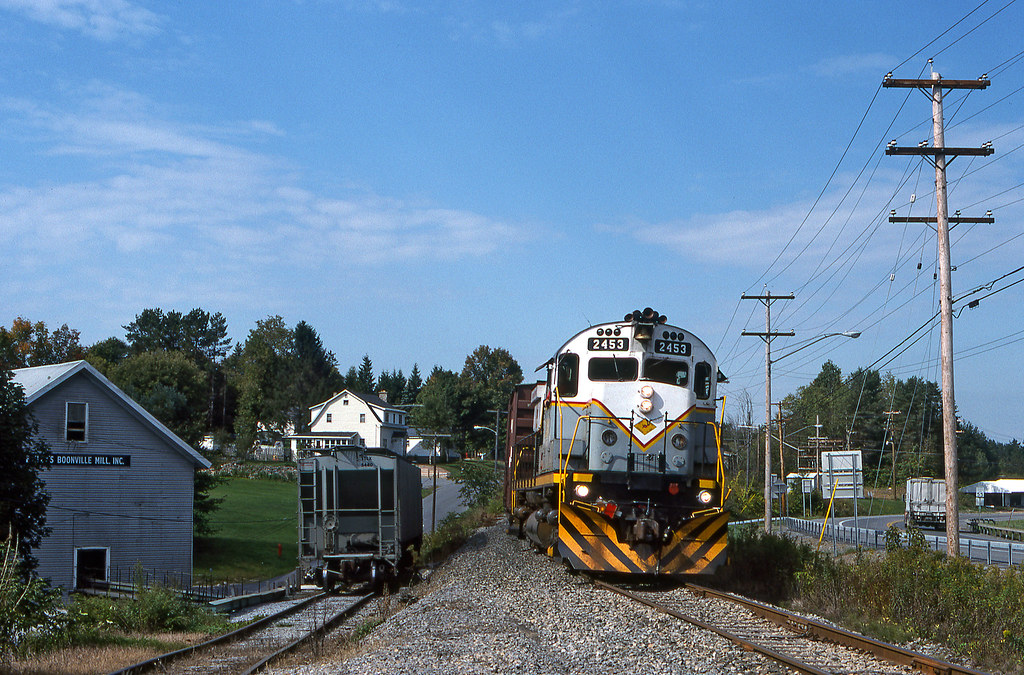Making the grade, cameo style…
Regular readers will recognise my love affair with small ‘cameo’ style layouts, where a prototype is distilled so that’s its essence can be represented in just 4ft, utilising theatre style presentation to control viewing angles and ensure the composition is viewed to its full potential…
 |
| Mohawk, Adirondack, & Northern C425 No. 2453 takes a southbound freight through Boonville, NY on Sept. 25, 1998. (photo: Stanley Short, Flickr: https://flic.kr/p/29sbC5g) |
Until now I have always considered scenes where the track is either completely flat, or only slightly graded (bar the Claremont Paper scheme, which probably took gradients to the max). For mainline locomotives there are not really opportunities to model a visible grade in just 4ft. That changes today, as I present a prototype whose compact size and eclectic motive power captured my imagination.
These two videos by ‘Railroading Rambler’ on YouTube caught my attention whilst I was watching Alco and MLW videos. At first I thought the grade was exaggerated by the telephoto zoom lens on the camera but as you can see, that is not the case! The line drops steeply from the grade crossing to the mill, conductors must guide their engineer carefully to avoid the inevitable… yes apparently a car was propelled through the stops in Conrail days!
So here we have the opportunity to represent some quite severe grade in a compact space whilst utilising 4 axle road switchers, not just light footed GE switchers. I present Boonville Mill, a cameo in H0 scale…
Mounting the ‘mainline’ at half the vertical height of the viewing window would be interesting, feeling so different to other cameos I’ve designed or created. The spur to the crossing is just over 80m, so 1m in H0, total shelf cameo size. The main may benefit from remote uncoupling if we are to leave cars there, as vertical height in the layout may be limited if the track is at half the viewing window. Otherwise, I present a relatively straight forward composition of some impressive North American short-line railroading in a compact space. The mill and station buildings would reward the scratch builder although Walthers or other kits may provide stand in for those interested in a faster project.
This design shows better than most the benefit that a closely cropped presentation gives to the modeller. By controlling what we see, and how we see it, the prototype is more readily distilled into a compact space. What is more, these smaller scenes are somehow more intimate, inviting us into their confines not to mention quicker, and probably as important in these times, easier on the wallet.
I’d love to see these schemes built, but if you’d like some help in designing your own project, I offer a layout design and build service. Get in touch for a proposal using the contact form in the menu. In the meantime, I hope this little slice of New England has your creative juices flowing. Until next time, more soon…

Atlas has recently released a C424 in Mohawk Adirondack & Northern paint too....very timely
ReplyDeleteIndeed, and the Otter Valley are doing a OSR ex BC Rail M420 which is close to those on the MA&N too…
DeleteWhat a cool little siding!
ReplyDeleteIndeed Steve, I think it’s the change of grade that makes it so interesting. I wonder how many of us could work in a little height variation in our otherwise flat railroads.
Delete